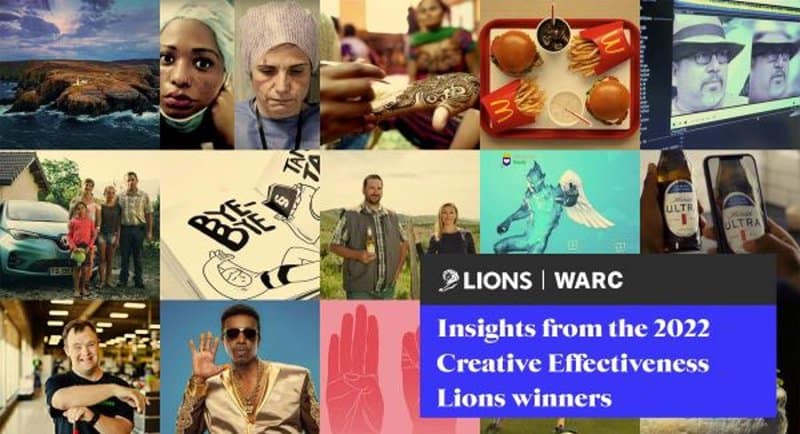WARC has released a report identifying trends and themes common to the award-winning campaigns of this year’s Cannes Creative Effectiveness Lions, which celebrate the measurable impact of creativity.
On the importance of rewarding creative effectiveness, this year’s jury president Raja Rajamannar, chief marketing and communications officer, Mastercard, said: “Marketing as a discipline is living an existential crisis: it’s losing its credibility, its gravitas, its stature. CEOs and CFOs are perceiving marketing to be fluffy; they have very little confidence in their marketing teams being able to drive business growth.
“With some companies even disposing of CMO roles, the marketing function is getting fragmented. This is why it’s important to focus on creative effectiveness: proving marketing’s impact and ROI for businesses will bring it back to the C-suite table and give it the gravitas and stature that it deserves.”
Chiara Manco, commissioning editor, Case Studies, WARC, said of the report: “Findings in this study are critical to understanding how marketers are driving business performance. We’ve analysed data from all the entries, interviewed jurors and spoken to winners to unearth insights into how the creative has led to demonstrable results.
“Our observations, together with the award-winning case studies included in this report, will help advertisers, agencies and media owners use the power of creativity to increase marketing effectiveness.”
The four key themes highlighted in the WARC report on “Insights from the 2022 Cannes Creative Effectiveness Lions winners” are:
1. Tapping into fans supercharges creative ideas
Fan-first approaches can drive engagement with specific fandoms while being the starting point of mass-reach campaigns. Cheetos, Michelob and McDonald’s explored the potential of engaging fans, which is reflected in an increase in ‘participation’ as a creative strategy this year.
Jury member Jennifer ‘JJ’ Healan, VP, US marketing, brand, content and engagement, McDonald’s, said: “Fan truths’ were key to unlocking our brand voice. They help us show McDonald’s through the eyes of a fan and are now at the heart of all our creative strategies.”
2. Ecosystems for change are brands’ new growth engine
As the discourse around purpose evolves, there is a new focus on long-term platforms able to deliver business growth while tackling systemic issues. Renault and Three created ecosystems to show their products in action, and Michelob transformed its supply chain to help farmers transition to organic.
Jury member Patricia McDonald, global chief strategy officer, Dentsu Creative, said: “We’ve seen a clear shift from effective campaigns to platforms and ecosystems for growth. Brands are not just raising awareness of an issue, but really making a difference and accelerating business growth through good.”
3. TV returns to fuel visually arresting creative
With lockdowns leading to shifts in media consumption, TV became a trusted companion for at-home audiences. Data shows TV was the lead media for 47% of the shortlist, and winners used it for powerful visual executions.
Michelle Morgan, strategy director and Dan Eckrote, strategy managing director at Mindshare New York, the media agency behind Dove’s Gold winning campaign Courage is Beautiful said: “We strategically amplified our message via COVID-related TV programming. Additionally, we leveraged placement within news programming, which aligned with consumers’ increased viewership of networks such as CNN and MSNBC… With this work we showed how you can creatively tap into mass-reaching channels for a laser-focused strategy.”
4. Brands explore AI-driven creativity
Be it to repair fractions in society or for entertainment reasons, winners experimented with creative AI applications. For Michelob and the Canadian Down Syndrome Society, partnering with a tech giant was key to the success of the initiative. Reflecting this trend, partnerships rose in popularity this year: 40% of shortlisted campaigns used partnerships, up from just 1% last year.
Jury member Rosie Collins, head of strategy, BBH London, said: “In their applications of AI, brands were trying to stretch beyond driving their own business impact: they were actually investing in new approaches that other brands could also replicate. There was a real generosity emerging in the work.”
Summing up, WARC’s Chiara Manco added: “Uniting all of this year’s winners is ‘evolution’. A forward-facing attitude and willingness to embrace change and transformation. From shifts within the media landscape to technology applications and approaches to purpose, winners adapted and evolved to take new challenges head-on.”
Included in the “Insights from the 2022 Creative Effectiveness Lions winners” report by WARC are:
• Top tips for effectiveness entries, including judges’ advice to future entrants and best practice examples.
• In-depth exploration of the themes, including expert commentary, behind-the-scenes features and infographics.
• A neuroscientific analysis of the winners to uncover the inner workings of creative effectiveness.
• Summaries of winning case studies including results, takeaways and judges’ comments.
• Data analysis covering campaign objectives, creative strategies, media mix, hard and soft metrics, budgets and durations.
